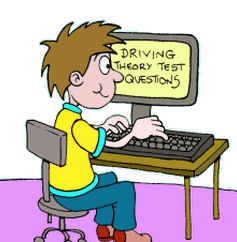How to pass the hazard perception test
First you need to understand just what a hazard is. Broadly, it is any element that can introduce risk into the driving scenario.
There are various different types of hazard that are possible, and when watching the clips you must be alert and work out what the hazard is in each case, or hazards as applicable.
Hazards could be something like a pedestrian walking along the road, or perhaps really inclement weather making driving conditions difficult and therefore potentially dangerous. Anything that could potentially create risk whilst driving can be deemed a hazard. Some hazards are of course more common than others. Not many of us will have come across a deer crossing the road unless we live somewhere very rural, but it is of course very much a hazard no matter how common or rare it is.
Whilst viewing the clips you will need to identify the hazards by clicking the mouse when you identify the hazard. The quicker you identify it the better, and the higher you score as a result. You are allowed to click either of the buttons on the mouse.
The scoring works on a rating of 0 to 5 for each hazard. If you get it totally wrong or miss it completely then that is 0, rising up to 5 for spotting it at maximal speed.
In order for you to pass the test, then you have to get a score of 44. Since there is a total of 5 x 15 points available (that is 75) then this works out as a requirement to score 59% on the test.
You don't have to wait long for the results of the tests, and get given these soon after taking the test. You need to pass both parts of the test (hazard and question based theory elements of the test) in order to successfully pass the driving theory test. More details on the specifics of the hazard perception test can be found in the other articles in this section.
Related Articles...
Your driving licence: getting it back
As the New Drivers Act article outlines, if you get six penalty points or more in the first two years of having a licence, then it is revoked and you have to retake both tests: the theory and the...
Your vehicle and driving
There is a lot to take in when you are learning to drive and when you are preparing for the driving theory test. Whilst a lot of it is common sense there is a considerable amount of information you...
Maintaining your car
It is essential that you look after your car and keep it in good condition. Not only is this paramount for your safety and that of other road users, but also it means that the longevity of your car...
Road position and large vehicles
In a car there are of course blind spots, but as soon as you drive a lorry you realise how significant the blind spots are for those vehicles.
For one simple thing even with vans you can't...
Prepare for driving theory tests
In order to pass tests, whether they are academic tests at school such as english, geography, spanish, french and so on, or to pass some other one - like theory tests - the methodology that can be...
Before Learning to Drive
The minimum age at which you are allowed to learn to drive a car on public roads is 17. As you probably know, you are not allowed to drive legally on your own until you pass your test. This means...
How to cancel a theory test
When you book a theory test, you of course choose a date that you think you are going to be able to make.
However with the best will in the world, there are a whole range of reasons why on...
How Pass Plus Works
What does pass plus contain? Well, it has six different modules and each of these ones focuses on a different set of conditions in which you might have to drive. These are in and around the town,...
Pass Plus Explained
There is an old saying of driving instructors which they state once you've passed your test, and that is that now you really learn to drive. The idea is that you are about to start driving...
Practical Driving Test
There is an online booking system available for a practical driving test which you can access from the DirectGov website.
The web address to do this is: ...
Back to home page of driving theory test questions

